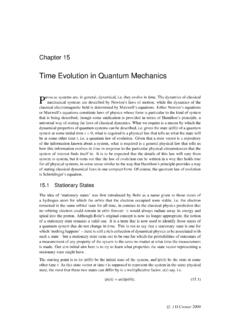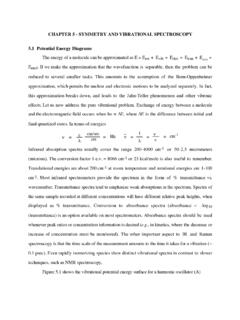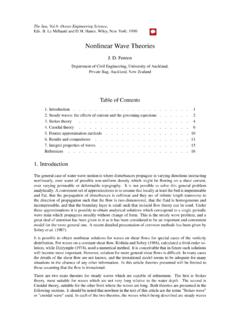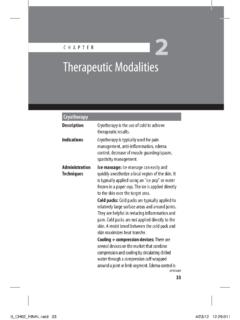Transcription of 1 Governing equations for waves on the sea surface - MIT
1 , WAVE PROPAGATION. Fall, 2004 MIT. Notes by C. C. Mei chapter FOUR. waves IN WATER. 1 governing equations for waves on the sea surface In this chapter we shall model the water as an inviscid and incompressible fluid, and consider waves of infinitesimal amplitude so that the linearized approximation suffices. Recall in the first chapter that when compressibility is included the velocity potential defined by u = is governed by the wave equation: 1 2 . 2 = ( ). c2 t2. q where c = dp/d is the speed of sound. Consider the ratio 1 2 . c2 t2 2 /k2.
2 2 c2.. As will be shown later, the phase speed of the fastest wave is /k = gh where g is the gravitational acceleration and h the sea depth. Now h is at most 4000 m in the ocean, and the sound speed in water is c = 1400 m/sec2 , so that the ratio above is at most 40000 1. 2. = 1. 1400 49. We therefore approximate ( ) by 2 = 0 ( ). Let the free surface be z = (x, y, t). Then for a gently sloping free surface the vertical velocity of the fluid on the free surface must be equal to the vertical velocity of the surface itself. , . = , z = 0. ( ).
3 T z Having to do with the velocity only, this is called the kinematic condition. 1. For small amplitude motion, the linearized momentum equation reads u = P gez ( ). t Now let the total pressure be split into static and dynamic parts P = po + p ( ). where po is the static pressure po = gz ( ). which satisfies 0 = po + gez ( ). It follows that u . = = p ( ). t t so that . p = ( ). t which relates the dynamic pressure to the velocity potential. Let us assume that the air above the sea surface is essentially stagnant. Because of its very small density we ignore the dynamic effect of air and assume the air pressure to be constant, which can be taken to be zero without loss of generality.
4 If surface tension is ignored, continuity of pressure requires that p = po + p = 0, z = . to the leading order of approximation, we have, therefore . g + = 0, z = 0. ( ). t Being a statement on forces, this is called the dynamic boundary condition. The two conditions ( ) and ( ) can be combined to give 2 . 2. +g = 0, z=0 ( ). t z 2. If surface tension is also included then we adopt the model where there is a thin film covering the water surface with tension T per unit length. Consider a horizontal rectangle dxdy on the free surface . The net vertical force from four sides is !
5 ! 2 2 . T T dy + T T dx = T + dx dy x x+dx x x y y+dy x y x2 y 2. Continuity of vertical force on an unit area of the surface requires ! 2 2 . po + p + T + = 0. x2 y 2. Hence ! 2 2 . g +T + = 0, z = 0. ( ). t x2 y 2. which can be combined with the kinematic condition ( ) to give 2 T 2 . + g = 0, z=0 ( ). t2 z z When viscosity is neglected, the normal fluid velocity vanishes on the rigid seabed, n = 0 ( ). Let the sea bed be z = h(x, y) then the unit normal is (hx , .hy , 1). n= q ( ). 1 + h2x + h2y Hence h h . = , z = h(x, y) ( ). z x x y y 2 Progressive waves on a sea of constant depth The velocity potential Consider the simplest case of constant depth and sinusoidal waves with infinitively long crests parallel to the y axis.
6 The motion is in the vertical plane (x, z). Let us seek a solution representing a wavetrain advancing along the x direction with frequency and wave number k, = f (z)eikx i t ( ). 3. In order to satisfy ( ), ( ) and ( ) we need f 00 + k 2 f = 0, h<z <0 ( ). T 2 0. 2 f + gf 0 + k f = 0, z = 0, ( ).. f 0 = 0, z = h ( ). Clearly solution to ( ) and ( ) is f (z) = B cosh k(z + h). implying = B cosh k(z + h)eikx i t ( ). In order to satisfy ( ) we require ! T. = gk + k 3 tanh kh 2. ( ).. which is the dispersion relation between and k. From ( ) we get = = (Bk sinh kh)eikx i t ( ).
7 T z z=0. Upon integration, Bk sinh kh ikx i t = Aeikx i t = e ( ). i . where A denotes the surface wave amplitude, it follows that i A. B=. k sinh kh and i A. = cosh k(z + h)eikx i t k sinh kh ! igA T k2 cosh k(z + h) ikx i t = 1+ e ( ). g cosh kh 4. The dispersion relation Let us first examine the dispersion relation ( ), where three lengths are present : the depth h, the wavelength = 2 /k, and the length m = 2 /km with r s g 2 T. km = , m = = 2 ( ). T km g . For reference we note that on the air-water interface, T / = 74 cm3 /s2 , g = 980 cm/s2 , so that m = The depth of oceanographic interest ranges from O(10cm) to thousand of meters.
8 The wavelength ranges from a few centimeters to hundreds of meters. Let us introduce r 2 g . m = 2gkm = 2g ( ). T. then ( ) is normalized to ! 2 1 k k2. 2. = 1 + 2. tanh kh ( ). m 2 km km Consider first waves of length of the order of m . For depths of oceanographic interest, h , or kh 1, tanh kh 1. Hence ! 2 1 k k2. 2. = 1+ 2 ( ). m 2 km km or, in dimensional form, T k3. 2 = gk + ( ).. The phase velocity is v u ! ug T k2. c= =t 1+ ( ). k k g . Defining m cm = ( ). km the preceding equation takes the normalized form v ! u c u1 km k =t + ( ).
9 Cm 2 k km Clearly s Tk c , if k/km 1, or / m 1 ( ).. 5. c*=c/ c m 2. 1. *= / m 0. 1 2 3 4 5. Figure 1: Phase speed of capillary-gravity waves in water much deeper than m . Thus for wavelengths much shorter than cm, capillarity alone is important, These are called the capillary waves . On the other hand r g c , if k/km 1, or / m 1 ( ). k Thus for wavelength much longer than cm, gravity alone is important; these are called the gravity waves . Since in both limits, c becomes large, there must be a minimum for some intermediate k. From dc2 g T.
10 = 2 + =0. dk k . the minimum c occurs when r g . k= = km , or = m ( ). T. The smallest value of c is cm . For the intermediate range where both capillarity and gravity are of comparable importance; the dispersion relation is plotted in figure (1). Next we consider longer gravity waves where the depth effects are essential. q = gk tanh kh ( ). 6.. c/ gh 1. 0 kh 2 4 6 8 10. Figure 2: Phase speed of capillary-gravity waves in water of constant depth For gravity waves on deep water, kh 1, tanh kh 1. Hence q r g gk, c ( ). k Thus longer waves travel faster.


















